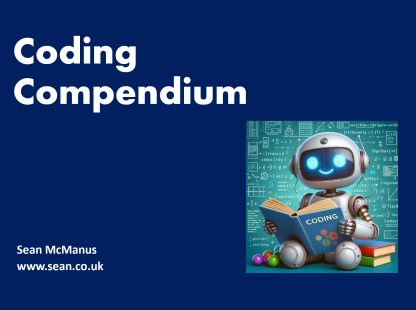
Coding Compendium
A free 100-page ebook collecting my projects and tutorials for Raspberry Pi, micro:bit, Scratch and Python. Simply join my newsletter to download it.
2004
Sean McManus introduces a flight simulator, chatroom and tubular bells in this 2004 review of Mike Oldfield's Maestro
 A silver statue stands on top of an icy mountain, overlooking the sea. From here we can see flocks of birds, a plane slowly crossing the blue sky and the lush green forest in the foothills. The music is peaceful and calming. My glider is floating on the breeze and Mike Oldfield is flying a spacecraft. "This is chillout 1," he says.
A silver statue stands on top of an icy mountain, overlooking the sea. From here we can see flocks of birds, a plane slowly crossing the blue sky and the lush green forest in the foothills. The music is peaceful and calming. My glider is floating on the breeze and Mike Oldfield is flying a spacecraft. "This is chillout 1," he says.
He throws me a medal. I either need to find another 23 to complete the game or need to collect four Gravitars and bring them to the Gravitar pen. The ability for players to give away medals can prove decisive - if you try to enter the final level with 25 medals instead of 24, you'll be sent to the start.
Winners - called Maestros - are rewarded with access to a room containing music only available there, which was described by early winner Fred as 'upbeat, sad, energetic and restful' on Mike Oldfield's messageboard. While there can be only one Maestro per game, the Maestro can invite other players into the winner's room.
It's this spirit of cooperation and teamplay that sets this game apart from many others. There is a messaging facility so that players can help each other solve the puzzles, explore together or just use the game as an attractive chat environment. Mike is often on-hand to offer gentle hints and encouragement. If you want to play with a select group, you can use your computer as a private game server.
To be seen by other players, you have to pilot an avatar, such as a glider or plane. The controls can be frustrating at times and the inability to look around without moving is irritating, but there's no pressure and time spent learning to fly is a good investment.

A mind-warping maze in Maestro
Apart from a dastardly maze, the puzzles aren't easy to spot. The game is about exploring how you can interact with objects and the different environments available. It's not a game for arcade addicts. Players who race through the worlds are likely to miss important details and skip some of the music and animation sequences.
The game is set on a spaceship which frames a variety of abstract worlds. We swam with the fishes, flew with the birds and danced with the jigsaw pieces. We watched an army of robots march past and met a lonely one-eyed man on a beach. As we flew around, music would catch our ear and help us to home in on new surprises.
For some people, the game will seem too safe. There's no real danger, no violence and no explosions. Others will see the beauty of this and delight in the sights and sounds as they make new friends exploring Maestro.

A blind man, one of the characters in Mike Oldfield's Maestro
 This is Mike Oldfield's second game. His first was Tres Lunas, released as a CD Rom with the album of the same name in 2002, which premiered Mike's MusicVR engine.
This is Mike Oldfield's second game. His first was Tres Lunas, released as a CD Rom with the album of the same name in 2002, which premiered Mike's MusicVR engine.
"I have always liked the idea of computer 3D graphics, especially flight simulators, and I wanted to try to combine this with Music and Gameplay," says Oldfield. "When networking became possible I found an extra possibility for MusicVR."
Mike worked with programmer Colin Dooley to develop first the tools used to build the games and then the games themselves. "Typically I would email him asking for a button which had a certain function like making a zone around a 3D object and specifying a soundfile that would emit from that zone and track across the screen as the object moved," says Mike. "Multiply this by some 20,000 buttons and you will get an idea." The resulting software, Newlook, was used to design the game once models had been built using Maya and 3D Max and textures had been designed with Photoshop.
The music was recorded in Mike's sound studio and edited using Soundforge on the PC. "The main new music is the theme from the Maestro level called Maestro," says Mike. "You can only hear this if you solve the Gravitar puzzle but there are other new soundtracks and also tracks from the rerecording of Tubular Bells."
Mike's unsure about future plans for Internet projects. "Let's see how this goes," he says, "but I am open to new ideas. Maybe we are working towards the Star Trek Holosuite."
© Sean McManus. All rights reserved.
Visit www.sean.co.uk for free chapters from Sean's coding books (including Mission Python, Scratch Programming in Easy Steps and Coder Academy) and more!

A free 100-page ebook collecting my projects and tutorials for Raspberry Pi, micro:bit, Scratch and Python. Simply join my newsletter to download it.

Web Design in Easy Steps, now in its 7th Edition, shows you how to make effective websites that work on any device.

Power up your Microsoft Excel skills with this powerful pocket-sized book of tips that will save you time and help you learn more from your spreadsheets.

This book, now fully updated for Scratch 3, will take you from the basics of the Scratch language into the depths of its more advanced features. A great way to start programming.

Code a space adventure game in this Python programming book published by No Starch Press.

Discover how to make 3D games, create mazes, build a drum machine, make a game with cartoon animals and more!